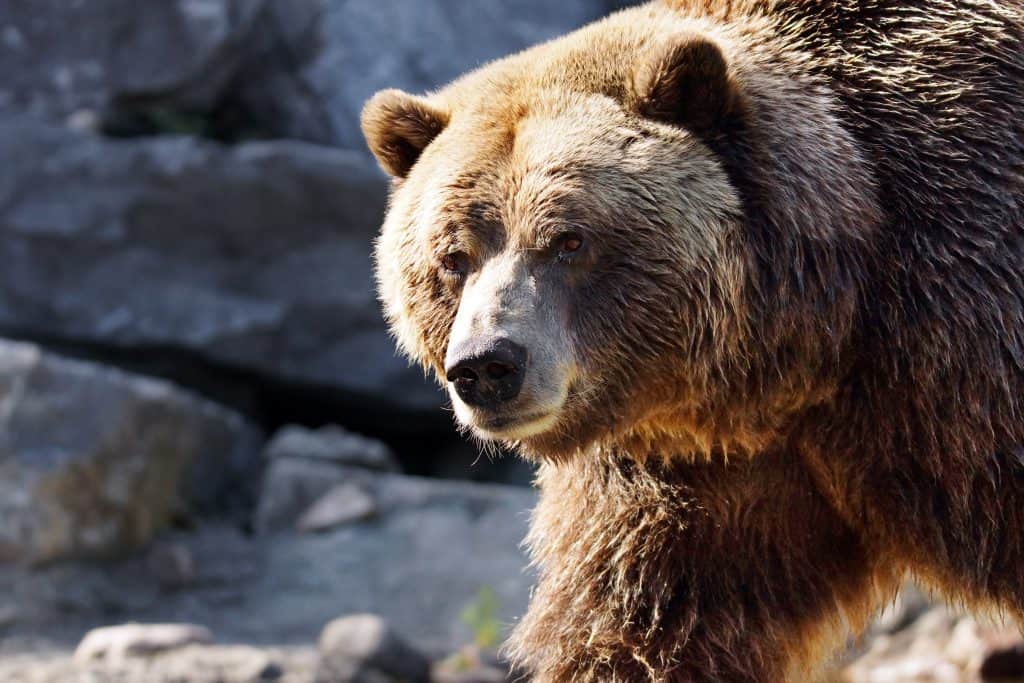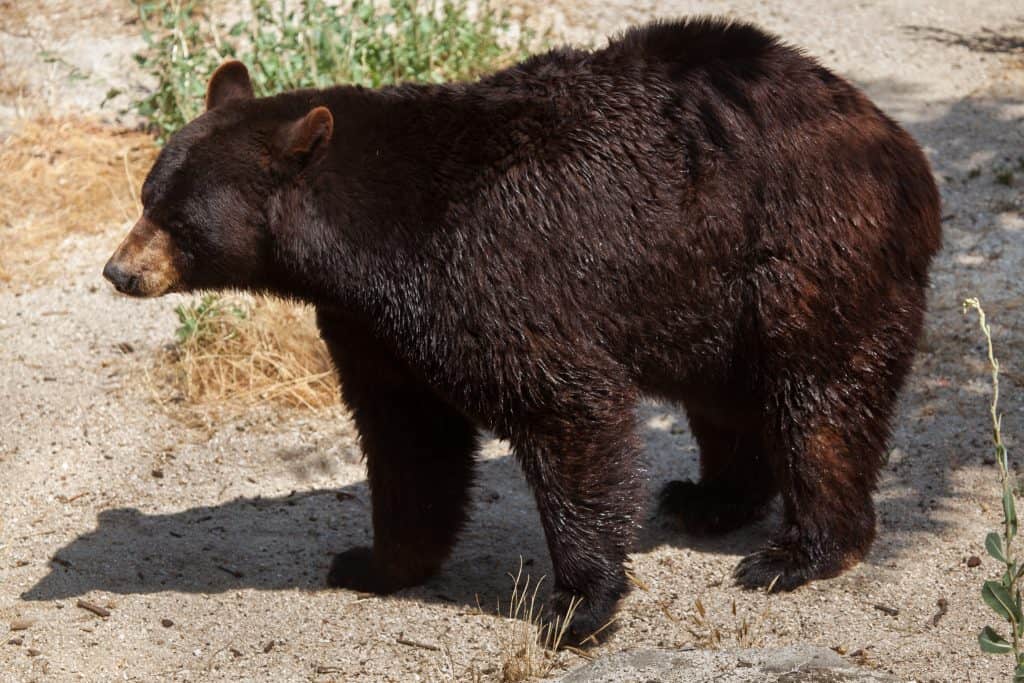Trekking lets you connect with nature, but it also exposes you to lots of natural hazards and dangerous wildlife. One of the biggest concerns for hikers and trekkers is bear attacks. Bears are powerful predators and can easily be attracted to the tasty food (or even deodorant) that you might have brought with you.
Trekkers can avoid bears by traveling with a group, making noise, and properly storing food and smelly items. In the event of an encounter, play dead for Grizzly bears and try to escape from black bears. If they attack, defend yourself with bear spray.
Bears are dangerous animals, but there are many ways that you can avoid them, or de-escalate conflicts before they attack. As long as you properly identify the type of bear and take the right precautions, you’ll be better equipped to deal with these wild animals.
Avoidance Tactics
In a lot of cases, bears can be avoided altogether if you’re careful. In general, these animals won’t seek out a fight with humans if they know you’re around. Generally they’re attracted by the scent of food or startled by unexpected humans in their territory.
So if you let bears know that you’re around (and aren’t a tasty treat) there’s a good chance you’ll have a bear-free trek. There are a few strategies you can try.
Travel With A Group
Bears are much less likely to go after a group than they will an individual. You’ll have more backup with a group, plus you’ll make a more off-putting target if the bear is feeling aggressive. You should never travel by yourself on a trek regardless, but certainly don’t do it in bear country!
Make Noise
Bears are sensitive to sounds and smells, so they’ll usually know you’re there before you spot them. Again, most bears won’t actively seek out a fight, and it’s much easier for them to move out of the way and let you pass by. So try to make a good amount of noise as you travel! Talking with people in your group or playing music on portable speakers is a good way to do this.
Note: Avoid making certain sounds that might mimic distressed animals. Screaming, shouting, and blowing whistles can activate a bear’s predatory instincts and draw them closer.
Properly Store Food
Bears have a great sense of smell and they can easily be attracted to a campsite. If your food isn’t well-sealed and stored, they might get dangerously close in order to get a taste. They can even be attracted by scented products like sunscreen, deodorant, and perfume. Use unscented products as much as possible and NEVER keep food in your tent.
Store your food in a bear-proof container at least 100 feet away from your campsite. This way, if a bear does happen to come calling, you’ll be out of harm’s way.
Watch For Warning Signs
You’ll usually be able to tell if there are bears in your vicinity. Keep an eye out for potential attractants, such as animal carcasses, running water, or ripe berry bushes. Footprints and bear scat is another good way to know if they’ve been around recently! Keep moving and stay alert if you spot these signs.
Identifying The Bear
Despite our best efforts, sometimes nature throws a curveball at us and we end up face to face with a bear. When this happens, it’s vitally important that you recognize what type of bear you’re looking at. Grizzly bears and black bears are the two main species you’ll encounter in North America, but they are different animals that require different responses.
When it comes to telling them apart, you can’t go by color alone. Despite the name, black bears aren’t always colored black. They can appear in shades of black, brown, red, and even white! The same thing is true of Grizzlies, so you need to look for other distinguishing characteristics.
First of all, check their physique. Grizzly bears have a large, prominent hump on their back. Black bears on the other hand, have slightly raised rumps. As one bear-aware slogan says, “Grizzly bear = raised hump and black bear = raised rump.” (Source)
You can also look at their claws. Black bear claws are fairly short, and you usually can’t see them from a distance. On the other hand, Grizzly bears have large, pronounced claws that are always visible. They can be up to 4 inches long.
These two differences should give you a good idea of the bear you’re dealing with, but you can also check the ears if you’re not sure. Black bears have large almost pointed ears, while Grizzlies have small, rounded ears.
Once you recognize the type of bear, you can move on to dealing with it appropriately.
Grizzly Bear Encounters

Grizzly bears are often more aggressive than black bears, so it’s important that you don’t attempt to threaten or intimidate them! Instead, calmly announce your presence. You’ll want to say things like, “Hi bear,” or “I’m over here bear.” This will help because it ensures that the bear won’t be startled by your presence, and you also identify yourself as a human, not a prey animal.
If the Grizzly does continue to approach or charge, play dead. Lay down on your stomach and wrap your arms around your head/neck. Keep your backpack on, since this provides extra protection. Spread out your legs so you’re harder to turn over, and lay as still as possible.
If they attack in earnest, fight back! Use bear spray, rocks, and anything else you can to defend yourself.
Black Bear Encounters

Black bears are generally smaller and more skittish compared to Grizzlies. If you run into a fairly small black bear, you can try to intimidate them. Never attack or threaten cubs though, since a parent could be nearby. Make yourself as large as possible and be loud. In many cases, this is enough to scare them off.
You can also try the same initial tactic as the Grizzly encounter. Announce your presence calmly and move sideways, keeping the bear in your line of sight.
If a black bear continues to approach you, DO NOT PLAY DEAD. This is a sign of weakness that will invite them to attack. Instead, try to escape into a building or car. If there’s no place like that nearby, fight back with bear spray, rocks, and anything else you have on hand.
Defense Tactics
When push comes to shove, you may need to attack the bear if it doesn’t back off. This is a worst case scenario, because the majority of encounters can be avoided or de-escalated before reaching this point. However if you the bear won’t stop advancing, you should turn to a defensive tactic.
One of the best resources for a bear attack is bear spray. This is an aerosol spray that irritates the eyes, nose, mouth, and skin of a bear. It will temporarily blind and distract them, giving you time to escape. In most cases, bear spray is the most effective method that will prevent long-term injuries to both you and the bear.
Some hikers like to carry firearms for extra protection. Hunting rifles are usually the most powerful and effective, but they can be heavy and unwieldy, especially for trekkers. There is also a risk of making the situation worse by non-fatally injuring the bear.
The choice is yours, but just make sure you’re weighed the pros and cons of each option.
Final Thoughts
Bears are natural parts of the outdoors. Many hikers and trekkers have had some kind of experience with a bear, whether directly or indirectly. However, there are ways to stay safe on the trail as long as you make your presence known, take the proper precautions with your food, and deal with encounters appropriately.
Related Content
Hiking is a great activity that anyone can get into. There are trails all over the world that range from easy nature walks to intense full-day climbs. You’ll want to properly prepare for any hike you take though, and make sure you have the right supplies and level of endurance.
If you get bored during hikes and backpacking trips, you can add some entertainment by listening to music/podcasts, playing games on the trail, setting personal challenges, and collecting trailside items. Traveling by yourself can be boring, so find a friend or a group to go with you.
Sources:
- America’s State Parks, “Staying Safe Around Bears To Avoid A Bear Attack“
- Where The Road Forks, “BEAR SAFETY TIPS: HOW TO AVOID BEARS WHILE HIKING AND CAMPING“
- National Park Service, “Staying Safe Around Bears” and “Storing Food“
- Yellowstone Bear World, “What’s the Difference Between Black Bears and Grizzly Bears?“
- livingonthedirt.com, “Grizzly Bear vs. Black Bear Encounters“
